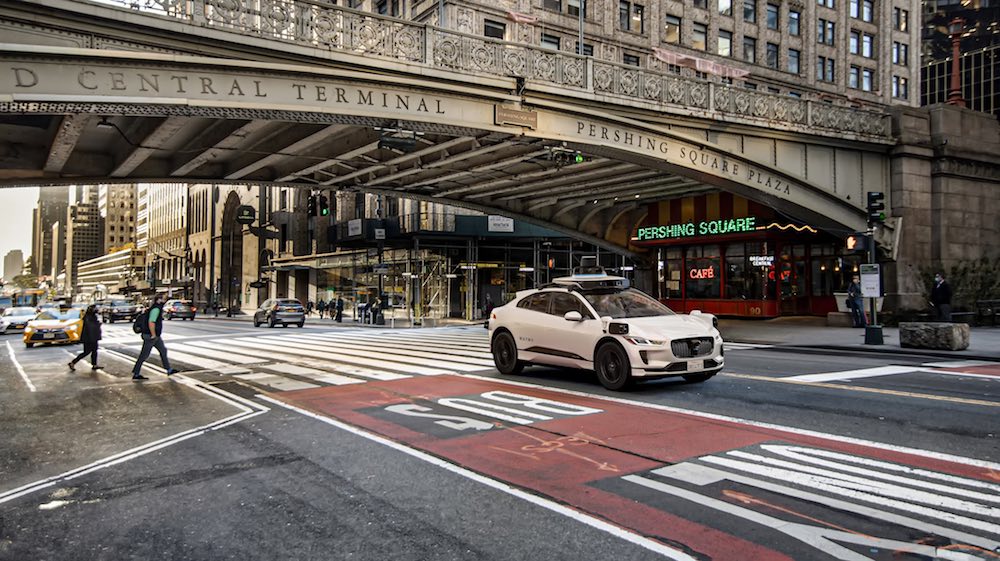|
Listen to this article  |

Starting tomorrow, November 4, Waymo will begin mapping the streets of New York City. Waymo said five of its Chrysler Pacifica minivans will be driving in Manhattan, primarily south of Central Park. Its operations will extend down through the city to the financial district and also out to a small section of New Jersey through the Lincoln Tunnel.
The vehicles will only operate during the day and will be driven manually at all times. Waymo said it’ll have two human “autonomous specialists” in each vehicle at all times – one in the driver’s seat and one in the passenger seat. At a later date, Waymo plans to bring “several” of its zero-emission Jaguar I-PACEs, also driven in manual mode with onboard autonomous specialists, to drive those same streets.
Waymo said NYC’s challenging driving environment will improve the ability of its autonomous driving system, Waymo Driver, to perceive and predict the actions of other road users. Unfortunately, don’t expect a Waymo robotaxi service, similar to what’s available in Arizona, to be up and running in NYC any time soon.
“We don’t have any immediate plans to launch [a robotaxi service] in New York City,” a Waymo spokesperson told The Robot Report. “We’ve driven in dozens of cities to date but haven’t launched a commercial service in each one. We drive in these cities to help us train the Waymo Driver and we are able to apply those learnings broadly across our entire fleet.”
Waymo has tested in many other places, including Arizona, Death Valley, Miami, Michigan, San Francisco, Washington State, and more. This will be Waymo’s first time ever driving in NYC. Over the summer, Mobileye became the first company to receive a permit to test autonomous vehicles on NYC’s public roads. Mobileye released the following 40-minute video, which it claims shows an unedited drive around the city.
How Waymo maps a new location
Waymo wrote a blog in September 2020 that details its mapping process. When its mapping vehicles come across a rare or complex situation, Waymo said it can use this experience to help create a map and also train the perception and behavior prediction models.
“To create a map for a new location, our team starts by manually driving our sensor equipped vehicles down each street, so our custom lidar can paint a 3D picture of the new environment. This data is then processed to form a map that provides meaningful context for the Waymo Driver, such as speed limits and where lane lines and traffic signals are located. Then finally, before a map gets shared with the rest of the self-driving fleet, we test and verify it so it’s ready to be deployed.
“Just like a human driver who has driven the same road hundreds of times mostly needs to focus only on the parts of the environment that change, such as other vehicles or pedestrians, the Waymo Driver knows permanent features of the road from our highly-detailed maps and then uses its onboard systems to accurately perceive the world around it, focusing more on moving objects. Of course, our streets are also evolving, so if a vehicle comes across a road closure or a construction zone that is not reflected in a map, our robust perception system can recognize that and make adjustments in real-time.”

Learning from ‘heavy rain and dense snowfall’
NYC’s bustling avenues, unusual road geometries, complex intersections and evolving layouts aren’t the only benefit. Most U.S.-based autonomous vehicle operations have been conducted in sunny, dry climates such as Arizona and California. Scaling the technology to other types of climates remains a major challenge. Although Waymo’s vehicles won’t be driving autonomously, the company said NYC’s weather also provides a learning opportunity.
“The heavy rain and dense snowfall that we expect to encounter will build on the driving we’ve completed to date in the snow and rain, giving us more opportunities to assess the way our sensors perform in wet, cold conditions beyond our data augmentation and simulation testing,” Waymo said. “Experiencing icy, snowy conditions will allow continued improvement of the Waymo Driver in the real world, and we will apply those learnings across our entire fleet.”
Testing in NYC is similar to Waymo’s testing in Florida that started in 2019. At the time, Waymo said testing in Florida would give it “a better handle on how rain affects” the sensors it uses in its self-driving cars. Its Chrysler Pacifica minivans and Jaguar I-Pace drove on a closed course in Naples for several weeks before testing on public roads in Miami.
Waymo, along with competitor Cruise, recently received a permit to offer robotaxi rides to public passengers in California. Waymo’s permit allows it to operate its autonomous vehicles in certain parts of San Francisco and San Mateo counties. However, the vehicles must have human safety drivers behind the wheel. Waymo’s vehicles are approved to operate on public roads with a speed limit of no more than 65 MPH and can also operate in rain and light fog.
Waymo started public testing in San Francisco in August 2021 with human safety drivers behind the wheel. Waymo has been operating a Level 4 public robotaxi service in parts of Arizona since October 2020.
Credit: Source link


Comments are closed.